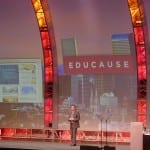What (American) Students Want
By Fiona Strawbridge, on 30 October 2016
One motivation for enduring the jet lag and culture shock of a long haul conference is the chance to find out what the big issues are in a different HE environment; Educause is a very good opportunity to do that as it reports on a number of surveys in the world’s largest higher education sector.
So, at this year’s Educause in LA, I went to sessions reporting the results of two very different surveys. One – the ECAR (Educause Center for Analysis & Research) Student Survey – asks students themselves about their attitudes to, experiences of and preferences for using technology in HE – a bit like a tech-focused NSS. The second – CampusComputing.net – surveys IT Directors’ views on e-learning; this seemed, to me, to be a rather odd perspective (why ask CIOs and not heads of e-learning who are closer to the area?). This post looks at the ECAR student view. To find out what the directors want I’ve written a more sketchy post…
The student survey was completed by a staggering 71,641 students from 183 institutions in 37 states and from 12 countries. The survey is a good benchmarking tool for participating institutions – they are able to compare their results against those from other institutions. Christopher Brookes and Jeffrey Pomerania from Educause presented a whistle-stop tour of the main findings. The full report is at the survey hub, and the infographic shown on the right is a nice summary. There weren’t too many surprises; in a nutshell, students own a lot of devices, and they view them as very important for their learning.
Their devices
In terms of devices, 93% own laptops and a further 3% plan to purchase one, and almost all say they are very or extremely important for their studies. 96 % own smartphones. Tablet ownership is much lower at 57%, and students rated them as less important to their studies than their smartphones. 61% of students have two or three devices, and 33% own four or more. Challenging for wifi, as we know…
Techiness
ECAR looked at techiness (sic) as measured by students’
- disposition to technology (sceptic vs cheerleader, technophobe vs technophile etc);
- their attitude (distraction vs enhancement, discontented vs contented etc) and
- their actual usage of technology (peripheral vs central, never vs alway connected etc).
Since 2014 all three measures have increased – so students are more techie now, and men are more techie than women. As I said, no great surprises.
Students’ experiences of technology
We were told that there was good news about students’ experiences of technology – 80% rated their overall technology experience as good or excellent. Now, it strikes me that if our scores for question 17 in the National Student Survey which asks about technology had been this low (we score 87%) we’d be very seriously concerned – but of course the questions are different so a direct comparison isn’t valid. But a good question is what is actually meant by “students’ experience of technology”. We were told that the main determinants were wifi in halls of residence and on campus, ease of login, having skilled academics, students’ own attitudes to technology, and it helped if technology used in class was perceived as relevant to their career.
Technology in teaching
Around 69% of students said that their teachers had adequate technical skills. More than half reported that technology was being used to share materials (61%) and collaborate (57%). There was less use which encouraged critical thinking (49%) and only a 34% of students said they were encouraged to use their own technology in the classroom.
82% of students reported preferring a blended learning environment over a fully online or fully offline one. Since 2013, the percentage of students who don’t want any online education has halved from around 22% to 11%. The number wanting a fully online experience has dropped slightly, but the number wanting a ‘nearly fully online’ experience has increased; the number wanted a more traditionally blended approach is stable at around 60%. Those who have previous experience of fully online courses are more likely to want a more fully online experience, and women were more likely than men to want to learn online – it was suggested due to a reluctance to speak up in a face-to-face environment.
Students found technology helped them with engagement with academics, with one another, and with content. There were some other interesting demographic effects. Women, first generation students, and non-white students were more likely to say that technology had a positive impact on the efficacy of their learning – it empowered them; it was helpful for communication, for helping them with basic terminology, and for getting swift feedback from others. It was found to enrich the learning experience in many ways.
And finally, students want more:
- Lecture capture – this mirrors experience at UCL
- Free, supplemental online content
- Search tools to find references – this has digital literacy implications as tools exist so perhaps students are unaware.
But, I guess, not more engaging or challenging online learning experiences. Ah well…
 Close
Close





